
The Ultimate Guide to Choosing the Right Supplement: What to Buy (and What to Avoid)
Share
Why Choosing the Right Supplement Matters
The supplement aisle is full of promises — glowing skin, better sleep, stronger immunity. But not all supplements are created equal.
Some are evidence-based and clinically dosed. Others are marketing fluff — underdosed, overpriced, and full of fillers.
Knowing how to read between the lines can save you money, protect your health, and get you real results.
Step 1: Know Your Goal
Start with clarity — what are you trying to fix or support?
-
Low energy or stress? Look into magnesium glycinate or B-complex.
-
Poor sleep? Try magnesium, L-theanine or herbal blends.
-
Skin, hair, nails? Collagen types I & III, vitamin C, silica.
-
Gut issues or bloating? Probiotics, digestive enzymes, or slippery elm.
-
General immunity? Vitamin D, zinc, elderberry, and liposomal vitamin C.
👀 No supplement is magic. But the right one, at the right dose, can be a game-changer.
Step 2: Check the Form — Not Just the Ingredient
There’s a big difference between what’s listed on the label… and what your body can actually use.
Common Examples:
-
Magnesium oxide = poorly absorbed, cheap filler
-
Magnesium glycinate or citrate = bioavailable, gentle, effective
-
Vitamin C (ascorbic acid) = fine in low doses, but buffered/liposomal forms absorb better
-
Folic acid vs methylfolate = huge difference if you have an MTHFR gene variant
Shop Practitioner-Grade Magnesium →
Step 3: Watch for Fillers, Sweeteners & Gimmicks
If your supplement contains:
-
Artificial sweeteners (acesulfame K, sucralose)
-
Synthetic colours (Red 40, Yellow 5)
-
Bulking agents and flow aids (talc, titanium dioxide)
…it’s time to upgrade.
Look for clean-label brands that skip the junk and use excipient-free or food-based ingredients. At GoodnessBox, we only stock supplements we’d use ourselves.
Explore Our Clean Supplements →
Step 4: Avoid These Red Flags
🚩 Proprietary Blends: You don’t know how much of anything you’re getting. Skip it unless fully disclosed.
🚩 Therapeutic Dose Missing: Just because an ingredient is listed doesn’t mean it’s dosed effectively. Always check the mg amount against research.
🚩 No Third-Party Testing: If they’re not transparent about quality testing — don’t trust the label.
Step 5: Match It to Your Lifestyle
-
Vegan or vegetarian? Look for supplements without gelatin or animal-derived ingredients.
-
Allergies or sensitivities? Avoid common allergens like soy, dairy, gluten, or nuts.
-
On medication? Some herbs or nutrients interact — check with a practitioner before starting anything new.
💡 Not sure? Start with one targeted formula and monitor how you feel — less is more.
Step 6: Don’t Chase Trends — Choose Function
Every year there’s a “hot” new supplement — mushroom blends, ashwagandha, adaptogens. Some are amazing. Others are just hype.
Stick to what your body actually needs. Popular ≠ effective for you.
📌 Example: You may not need 10 adaptogens if your root issue is gut inflammation or poor nutrient absorption.
Check Out Targeted Wellness Collections →
Bonus Tip: Combine Smartly — But Don’t Overstack
More isn’t always better. Combining too many actives can cause:
-
Competing absorption
-
Overlapping effects (e.g. too many sedatives)
-
Digestive upset
Instead, stack based on synergy:
-
Magnesium + B6 for nervous system
-
Collagen + Vitamin C for skin + tissue repair
-
Zinc + Quercetin for immunity
If in doubt, ask a practitioner or start with single nutrients.
Final Word
Choosing the right supplement isn’t about falling for the flashiest label — it’s about understanding ingredients, quality, and what your body actually needs.
At GoodnessBox, we curate only evidence-backed, practitioner-trusted products — no filler, no fluff.
👉 Start your supplement upgrade here →
FAQs
Q: How do I know if a supplement is good quality?
A: Look for clean ingredients, clinical dosing, no fillers, and third-party testing. Brands that use transparent, practitioner-level formulas are usually more trustworthy.
Q: Are expensive supplements always better?
A: Not necessarily. Some expensive brands have poor dosing or marketing fluff. The best supplements are well-formulated and evidence-based — not just expensive.
Q: What’s the difference between practitioner-only and retail supplements?
A: Practitioner-only products are usually more therapeutic, higher strength, and subject to stricter quality control. They're not always available off the shelf.
Q: Should I take multiple supplements at once?
A: Only if they serve a purpose. Too many overlapping formulas can cause side effects or interfere with absorption. Start with 1–2 key products based on your goals.